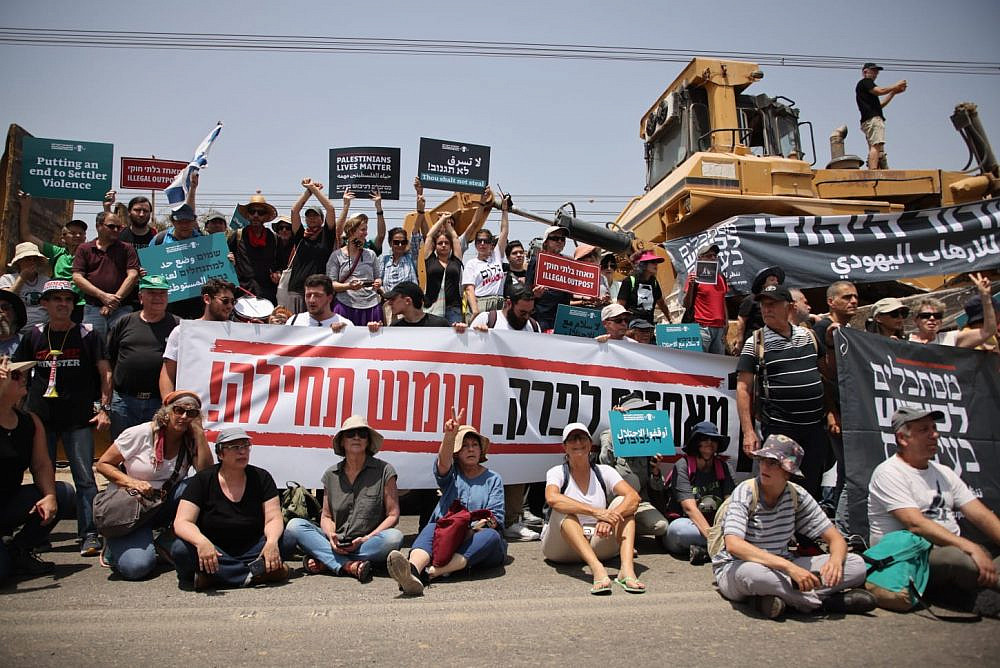This article was published in partnership with Local Call.
“We’re coming to dismantle the Homesh outpost!” read the banner disseminated on social media two weeks ago by a group of left-wing Israeli organizations, announcing their intention to show up to the unauthorized settlement in the northern West Bank last Saturday, May 28 — armed with a bulldozer.
As many expected, the army prevented the bulldozer from even crossing into the West Bank, and detained the driver in the Rosh Ha’ayin train station parking lot where the activists had gathered on Saturday morning before continuing on toward Homesh. But the protesters didn’t yield without a fight: they surrounded the police car to try to prevent the detention of the bulldozer driver, and they lay down on the road causing the police officers to have to repeatedly remove them by force.
Eventually, the activists continued on toward Homesh, but the army and police stopped their buses outside the settlement of Kedumim, miles away from their target. So the protesters decided to hold the demonstration there.
Beyond the stubbornness of the activists that was evident on Saturday, the very notion of “taking the law into one’s own hands” represented a noticeable change in tactics by the specific groups that initiated the action, and had already caused a major stir in the media and online among both right-wing and left-wing critics.
Organizers said ahead of the action that this tactical shift comes as a result of the influx of activists to the anti-occupation sphere from the “Balfour” protest movement of 2020-21, which sought to oust former Prime Minister Benjamin Netanyahu from office (and so-named for the street on which the Prime Minister’s residence in Jerusalem is located). Indeed, those who have for many years been attending left-wing protests in Sheikh Jarrah, the South Hebron Hills, or Lydd, or accompanying Palestinian shepherds in the Jordan Valley at risk of military or settler violence, have noticed a wave of new faces who arrived in the past year from the Balfour protests full of energy and new ideas for actions.
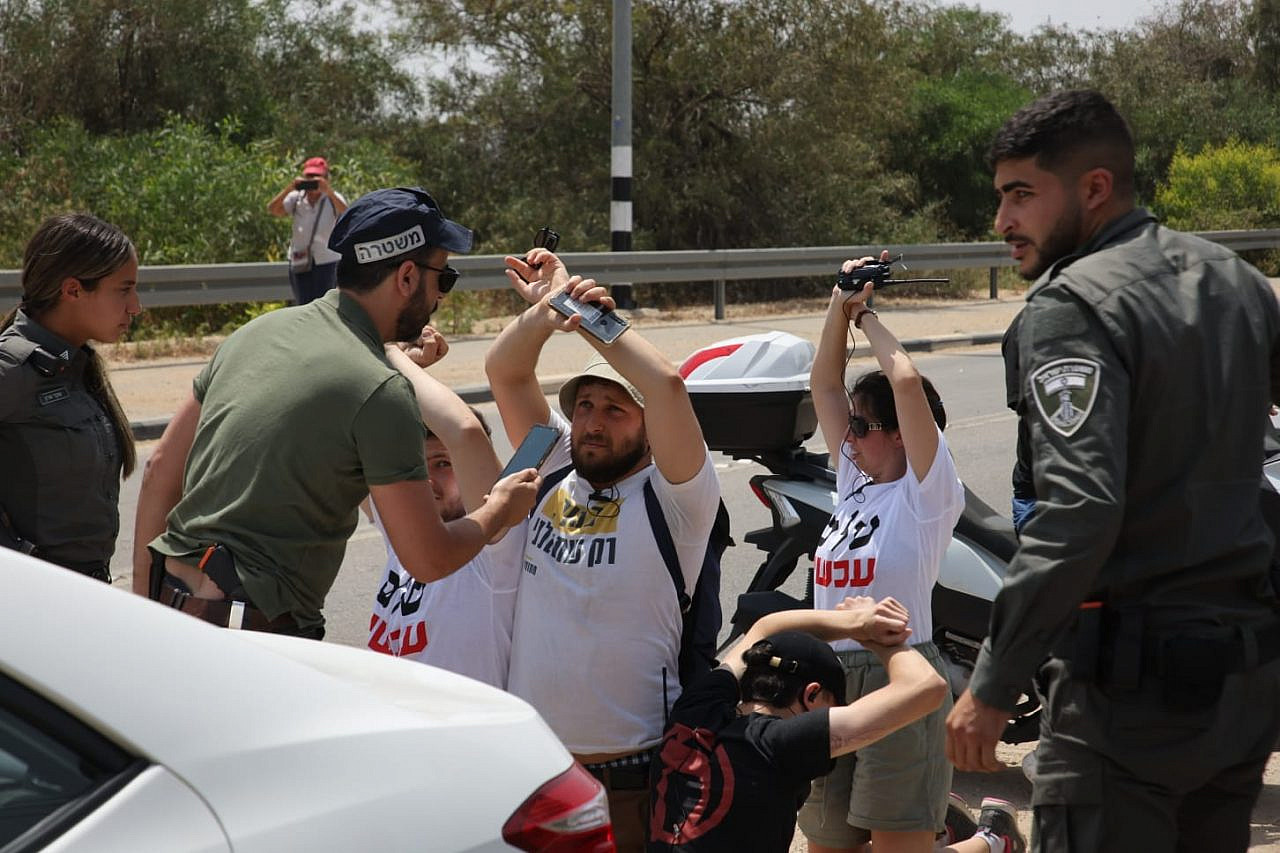
Now, having absorbed new activists from the Balfour protests, the anti-occupation groups involved in the Homesh demonstration are beginning to adopt the confrontational tactics that characterized them. The activists noted that their disappointment in the so-called “government of change” — which replaced Netanyahu a year ago — with regard to the Palestinian issue elicits a different approach, which will present a stronger challenge to the system.
“This protest [on Saturday] is a continuation of the tactics and way of thinking that we saw at Balfour,” said Dana Mills, interim executive director of Peace Now. In those demonstrations, she continues, “there was a challenge to the boundaries of the law, a statement that our voice is not being heard, and that the system does not work. What’s happening in the occupied territories is illegal and immoral, and I want to challenge the law.”
Besides Peace Now, the protest was supported by human rights organizations Breaking the Silence, Combatants for Peace, and Machsom Watch, left-wing groups Mehazkim, Zazim, the Harvest Coalition, and Jordan Valley Activists, and three groups that formed within or in the wake of the Balfour protests: Crime Minister, Mothers Against Violence, and Looking the Occupation in the Eye.
A legacy of direct action
Direct action by Israeli activists in the West Bank is nothing new – activists from radical leftist groups like Anarchists Against the Wall and Ta’ayush began joining Palestinian protests and accompanying shepherds in rural areas as far back as the early 2000s. These days, activists from several of the groups that participated in the Homesh demonstration on Saturday regularly join protests and olive harvests with Palestinians.
However, the feeling now is that this kind of rhetoric has shifted from the radical left to the mainstream of the Zionist left, which is why this event attracted wider attention and coverage beforehand, and featured prominantly in leading news sites on Saturday as events were unfolding.
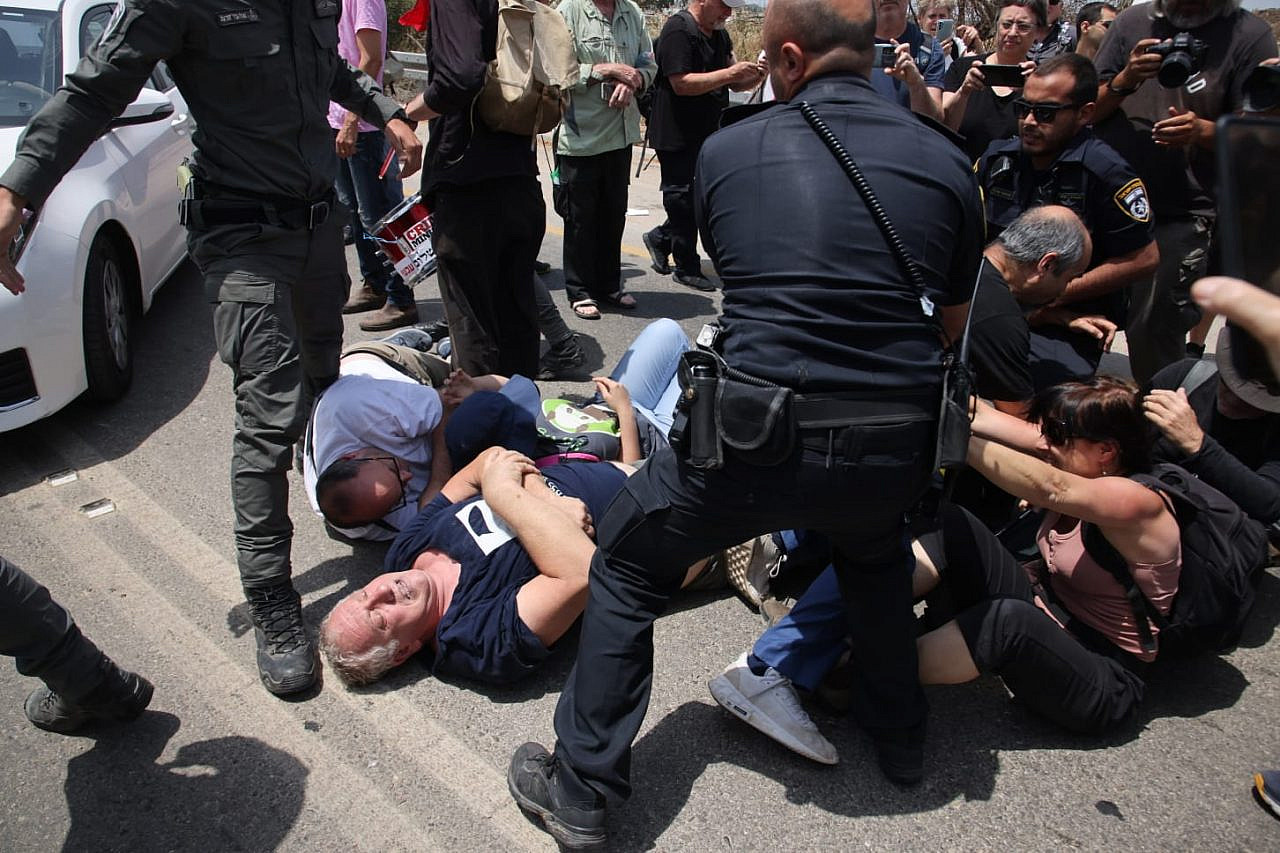
“This is definitely a step up for us,” added Mills. “It’s a change of tactics. We do not want to work only within the establishment. Peace Now was in the past a movement whose activists blocked roads or lay in front of bulldozers.”
Mills believes that the shift in approach reflects disillusionment with the so-called ‘government of change.’ “This government is more right-wing than previous governments without [left-leaning parties] Meretz and Labor, it’s building more housing units in settlements than its predecessors, and it does not keep any of its promises with regard to the occupation, in order to survive,” she continued. “The left-wing parties do not want to rock the boat. So the question is: What is our role here?”
The choice to focus on Homesh for this action was not incidental. Not only is the outpost unauthorized, it is also located in an area where Israelis are prohibited by law from staying. In addition, the High Court ruled back in 2013 that Palestinian farmers in the area should be allowed access to their land, but since then there have been a large number of violent attacks on Palestinians by settlers. Just last week, Defense Minister Benny Gantz and Foreign Minister (and Alternate Prime Minister) Yair Lapid reaffirmed that the outpost must be demolished.
After Yehuda Dimentman, a Jewish student at the Homesh Yeshiva (which settlers established without authorization) was shot dead by Palestinians in December 2021, the Jewish presence in the area has increased. Settlers have held several illegal protest marches, which have included the participation of Members of Knesset — with the army not only not preventing them but guarding and accompanying them. The movement of Palestinians in the area, meanwhile, has been severely restricted.
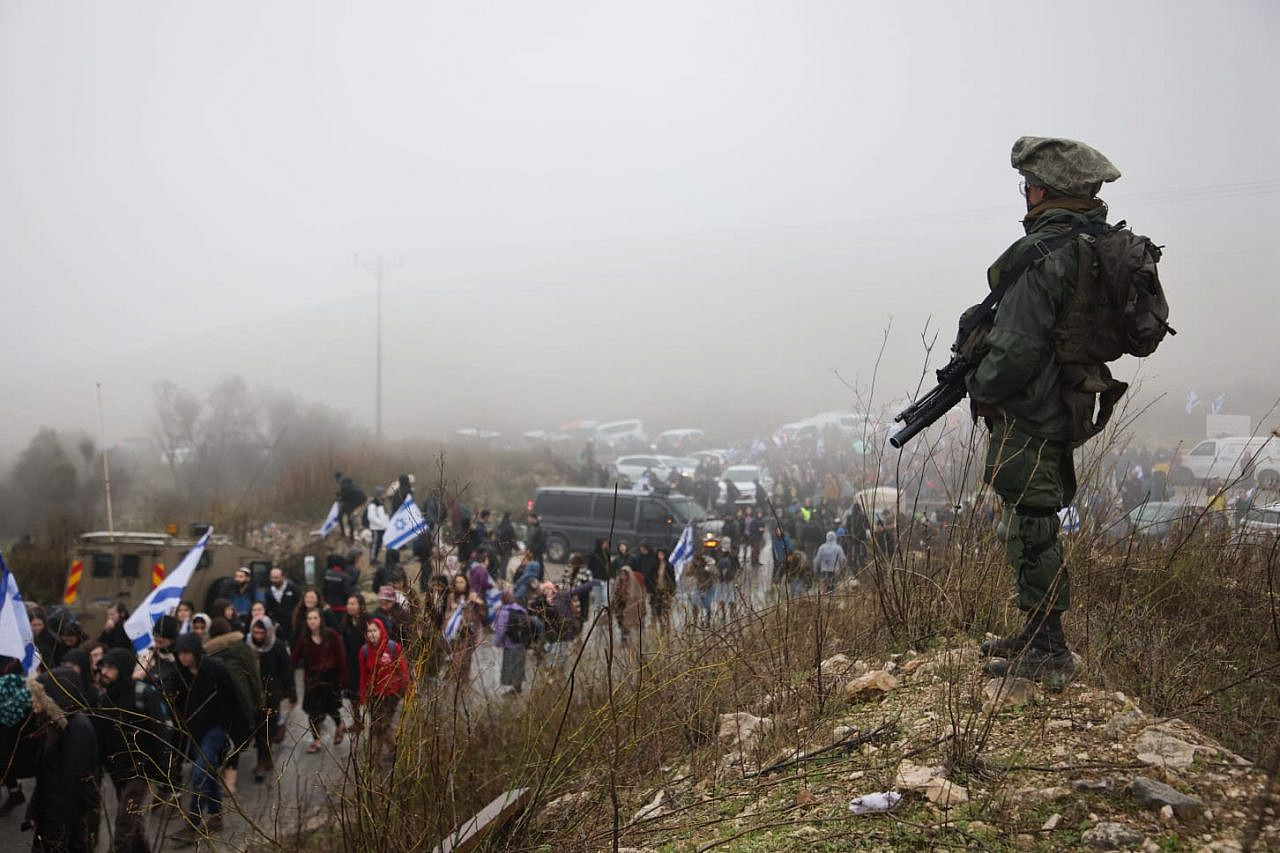
‘It’s a necessary evolution’
“I’m glad these groups adopted a new approach — it’s important,” said Yishai Hadas, who was one of the most prominent activists in the Balfour movement and among the founders of Crime Minister. On Saturday morning, Hadas was preemptively detained by police while driving to join the protest, on suspicion of disturbing the peace.
“There is an understanding that repeating the same thing does not bring results, so it’s time to do something a little different in order to reach mainstream public discourse,” Hadas continues. “Things may not change immediately, but it is impossible for one side [the right] to be hyperactive, and one side [the left] to be calm and gentle, and continue as if everything is normal.”
Alec Yefremov, director of public activities at Peace Now, is himself an embodiment of the transition from the Balfour protests to protests against the occupation. “There’s a wave of people who have found themselves in this struggle, and it makes a lot of sense,” he continued. “People joined the emergency struggle against the immediate threat of a dictatorship [inside of Israel], and when that threat was removed they moved on to the next most burning issue.”
According to Yefremov, this wave not only brought new people but also “a different way of struggling from what previously characterized the old and slightly dormant left camp. At Balfour we realized that it is not enough to stand beside the police and demonstrate in the square within their boundaries. You have to challenge, be stubborn, and stretch the boundaries. These tactics have migrated: there is a Balfourization of the struggle against the occupation.”
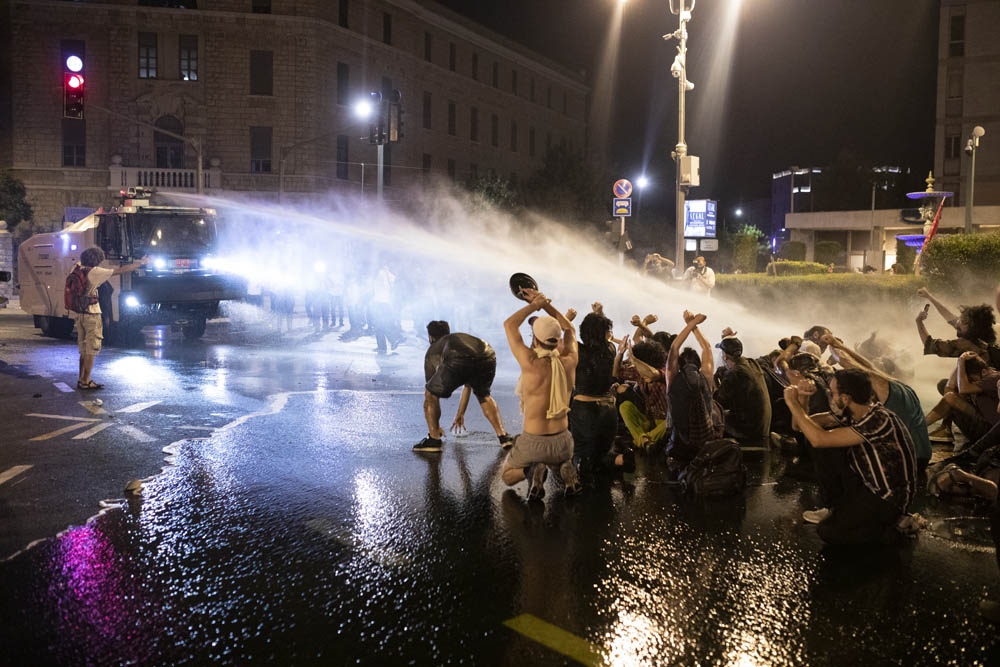
Hadas agrees that this is the influence of the Balfour protests. “It’s as clear as the sun,” he said. “And it’s good — it’s a necessary evolution. The issue of the occupation has been pushed to the side for more than 20 years, and now people are talking about “shrinking the conflict” instead of tackling the problems. We have no choice, we have to take action. It’s impossible to sit on the sidelines when extremism has become mainstream.”
Unlike at the Balfour protests, where Israeli flags were ubiquitous, activists from the groups that organized the demonstration on Saturday made sure not to bring flags. A couple of individual protesters did bring Israeli flags, however, which must have made for confusing viewing for Palestinian passersby who saw the same flag being waved by protesters in the left-wing demonstration against the occupation, and by the settlers who formed a spontaneous counterdemonstration nearby.
‘We succeeded there, we will succeed here too’
Guy Hirschfeld, a veteran activist in the Jordan Valley, was part of the permanent tent encampment at the Balfour protests. He is also one of the founders of Looking the Occupation in the Eye, and took many Balfour activists on tours in the West Bank. “There’s a new wind of change, brought in by activists who came from Balfour with a new style and new energy, and that’s welcome,” he said.
Looking the Occupation in the Eye organizes weekly protest encampments in front of the government compound in Tel Aviv, brings solidarity activists to support Palestinians at risk of settler violence in the West Bank, and holds small protests on bridges over major highways every Saturday. The idea for the latter was inspired by the Balfour protests that continued through the coronavirus lockdowns, during which activists demonstrated on bridges near their homes because they were unable to gather as usual outside the Prime Minister’s residence in Jerusalem.
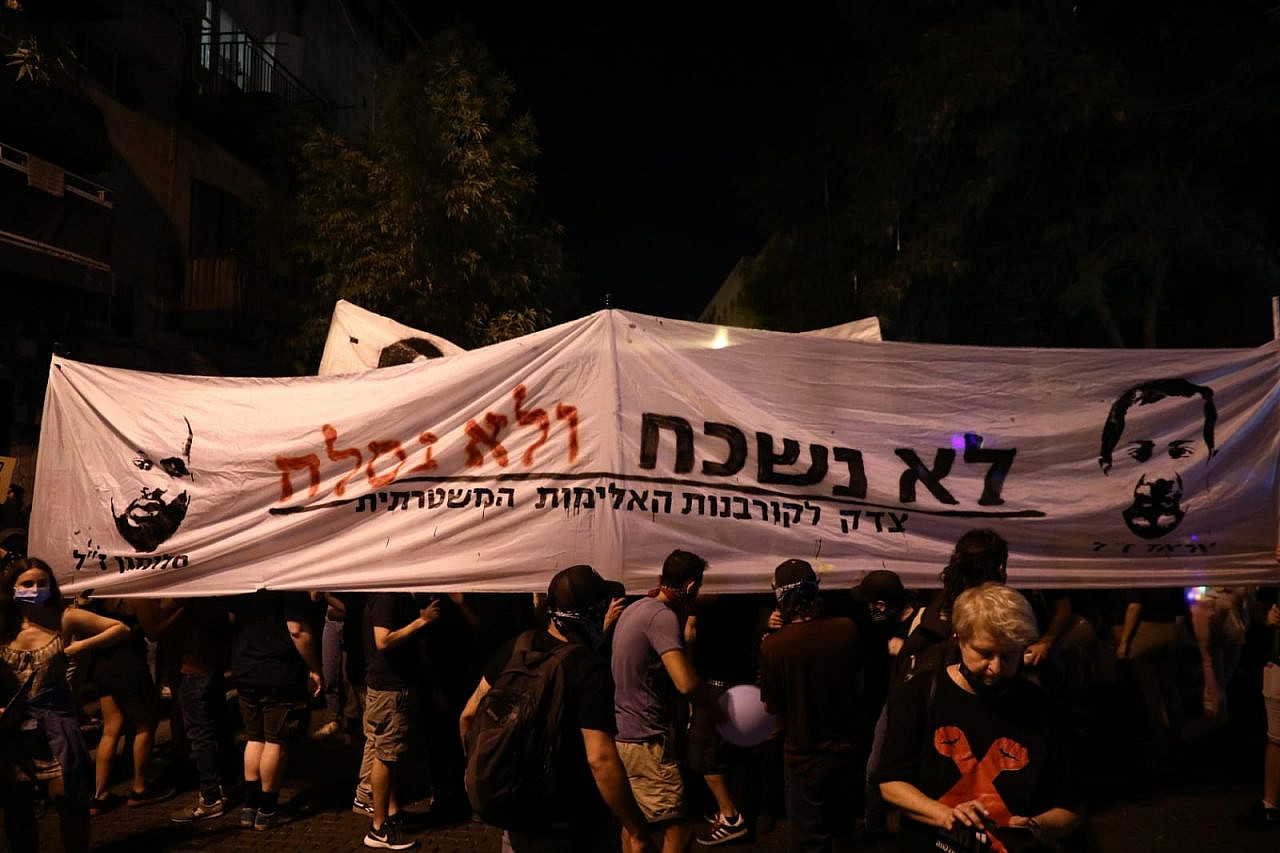
Hirschfeld believes that simply by being at the Balfour protests, where an active anti-occupation bloc was present each week and even organized marches from the Palestinian neighborhood of Silwan to Balfour, more people were exposed to the urgency of fighting the occupation. “Suddenly, people with a social and political awareness woke up,” he said. “People tell me to this day they weren’t aware [of the reality in the occupied territories], because in the mainstream news they call everyone there a terrorist.”
Now, according to Hirschfeld, those activists are giving new life to the struggle against the occupation. “People from Balfour arrived with the sense that ‘we succeeded there, we will succeed here too.’ Of course it’s different, but they brought energy. Many of them are full of purpose, and we hope it will only continue to grow.”
Responding to the criticisms against “taking the law into their own hands” and the claim that intending to demolish an outpost is a violent action, Yefremov said ahead of the demonstration:
“We’re going to do something that will put an end to the illegal situation. It’s impossible to fight it through Facebook posts; action needs to be taken on the ground. Coming with a bulldozer to an illegal structure is not violent. Even according to Israel, the occupier, they are there illegally.
“No one will raise a hand — not on a police officer nor on a settler,” he continues, “and there is no law prohibiting the dismantling of an illegal structure. For those who criticize us from within [the left-wing camp], the choice is between doing this and doing nothing.”
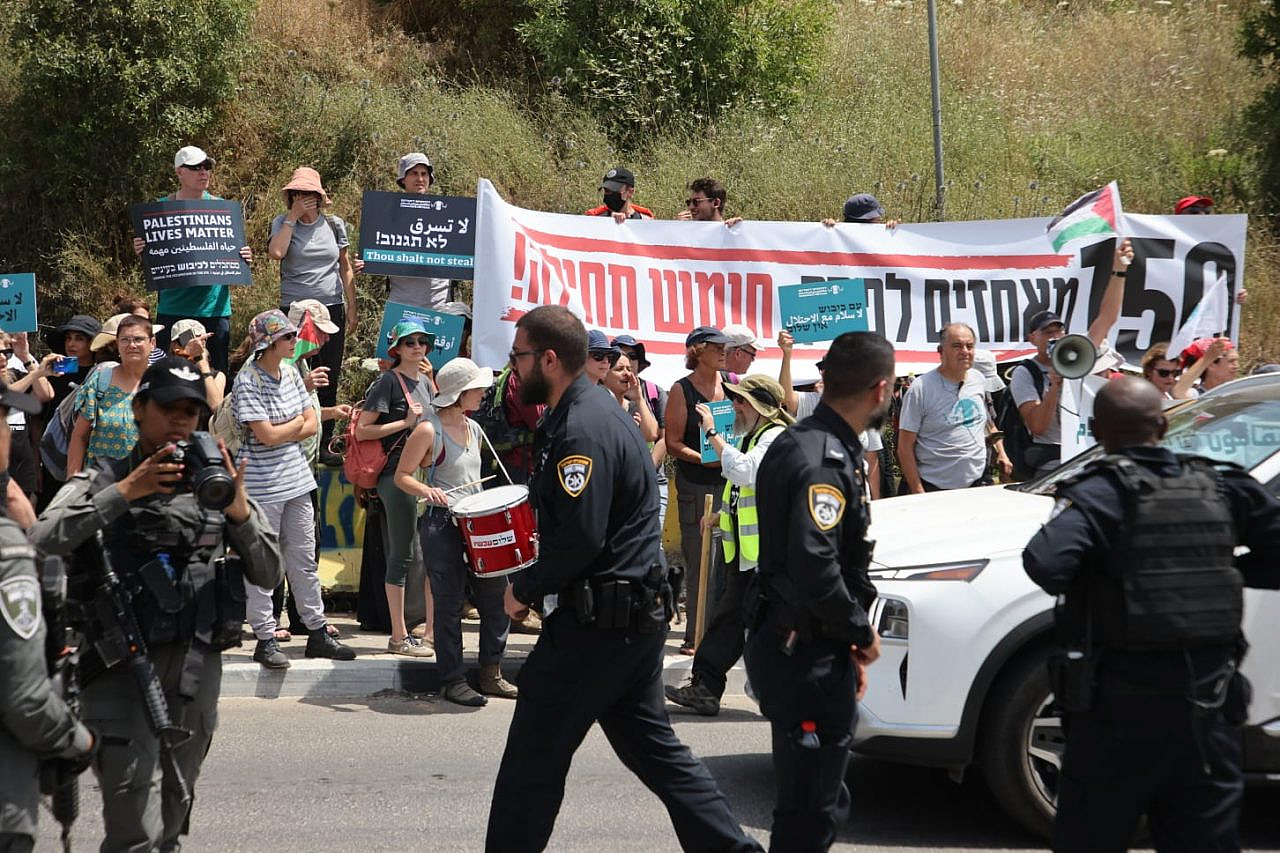
In contrast to the actions of the radical left in the West Bank, however, only Israelis participated in this protest. “It is clear that if Palestinians tried to do such a thing, they would encounter live ammunition,” said Mills. “We are taking advantage of our privilege here.”
Yefremov added that the activists were in close and ongoing cooperation with Palestinians behind the scenes. “We were at the village councils in Burka and in Bazaria [two of the villages on whose lands the settler outpost was built], and they are supportive. We asked them if they weren’t afraid that the action would harm them, and they replied that they live in a state of constant harm, and the action could not harm them further.”
A version of this article also appears in Hebrew on Local Call. Read it here.

